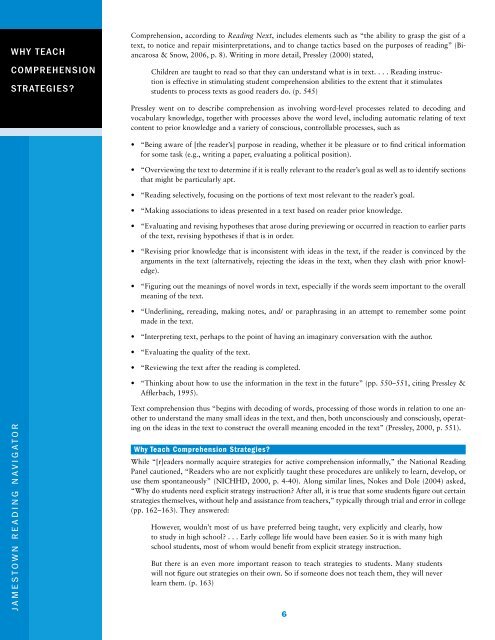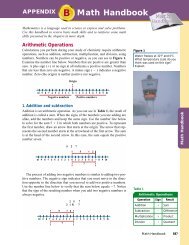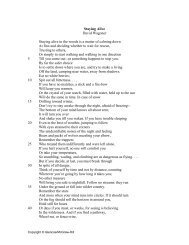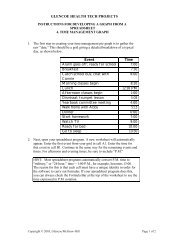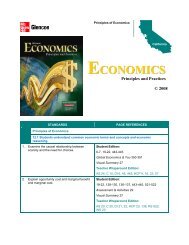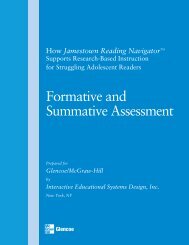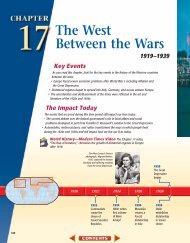Comprehension - Research
Comprehension - Research
Comprehension - Research
You also want an ePaper? Increase the reach of your titles
YUMPU automatically turns print PDFs into web optimized ePapers that Google loves.
WHY TEACH<br />
COMPREHENSION<br />
STRATEGIES?<br />
<strong>Comprehension</strong>, according to Reading Next, includes elements such as “the ability to grasp the gist of a<br />
text, to notice and repair misinterpretations, and to change tactics based on the purposes of reading” (Biancarosa<br />
& Snow, 2006, p. 8). Writing in more detail, Pressley (2000) stated,<br />
Children are taught to read so that they can understand what is in text. . . . Reading instruction<br />
is effective in stimulating student comprehension abilities to the extent that it stimulates<br />
students to process texts as good readers do. (p. 545)<br />
Pressley went on to describe comprehension as involving word-level processes related to decoding and<br />
vocabulary knowledge, together with processes above the word level, including automatic relating of text<br />
content to prior knowledge and a variety of conscious, controllable processes, such as<br />
• “Being aware of [the reader’s] purpose in reading, whether it be pleasure or to find critical information<br />
for some task (e.g., writing a paper, evaluating a political position).<br />
• “Overviewing the text to determine if it is really relevant to the reader’s goal as well as to identify sections<br />
that might be particularly apt.<br />
• “Reading selectively, focusing on the portions of text most relevant to the reader’s goal.<br />
• “Making associations to ideas presented in a text based on reader prior knowledge.<br />
• “Evaluating and revising hypotheses that arose during previewing or occurred in reaction to earlier parts<br />
of the text, revising hypotheses if that is in order.<br />
• “Revising prior knowledge that is inconsistent with ideas in the text, if the reader is convinced by the<br />
arguments in the text (alternatively, rejecting the ideas in the text, when they clash with prior knowledge).<br />
• “Figuring out the meanings of novel words in text, especially if the words seem important to the overall<br />
meaning of the text.<br />
• “Underlining, rereading, making notes, and/ or paraphrasing in an attempt to remember some point<br />
made in the text.<br />
• “Interpreting text, perhaps to the point of having an imaginary conversation with the author.<br />
• “Evaluating the quality of the text.<br />
• “Reviewing the text after the reading is completed.<br />
• “Thinking about how to use the information in the text in the future” (pp. 550–551, citing Pressley &<br />
Afflerbach, 1995).<br />
J a m e s t o w n R e a d i n g N a v i g a t o r<br />
Text comprehension thus “begins with decoding of words, processing of those words in relation to one another<br />
to understand the many small ideas in the text, and then, both unconsciously and consciously, operating<br />
on the ideas in the text to construct the overall meaning encoded in the text” (Pressley, 2000, p. 551).<br />
Why Teach <strong>Comprehension</strong> Strategies?<br />
While “[r]eaders normally acquire strategies for active comprehension informally,” the National Reading<br />
Panel cautioned, “Readers who are not explicitly taught these procedures are unlikely to learn, develop, or<br />
use them spontaneously” (NICHHD, 2000, p. 4-40). Along similar lines, Nokes and Dole (2004) asked,<br />
“Why do students need explicit strategy instruction? After all, it is true that some students figure out certain<br />
strategies themselves, without help and assistance from teachers,” typically through trial and error in college<br />
(pp. 162–163). They answered:<br />
However, wouldn’t most of us have preferred being taught, very explicitly and clearly, how<br />
to study in high school? . . . Early college life would have been easier. So it is with many high<br />
school students, most of whom would benefit from explicit strategy instruction.<br />
But there is an even more important reason to teach strategies to students. Many students<br />
will not figure out strategies on their own. So if someone does not teach them, they will never<br />
learn them. (p. 163)


